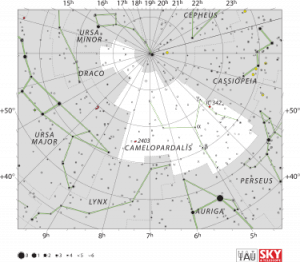Camelopardalis
Camelopardalis or the Giraffe constellation is a large, faint grouping of stars in the northern sky. The constellation was introduced in 1612 (or 1613) by Petrus Plancius. Some older astronomy books give an alternative spelling of the name, Camelopardus. Camelopardalis is in the part of the celestial sphere facing away from the galactic plane. Accordingly, many distant galaxies are visible within its borders. NGC 2403 is a galaxy in the Messier 81 group of galaxies, located approximately 12 million light-years from Earth.

Etymology
The giraffe's species name, camelopardalis (camelopard), is derived from its early Roman name where it was thought of as a composite creature, described as having characteristics of both a camel and a leopard. The word Giraffe is from Arabic dialectal zirafa, probably of African origin. "To the Romans, the giraffe was camelopardalis (camel marked like a leopard). The word giraffecomes from the Arabic zarafa. As a verb it means to jump or to hurry, leading to the noun one who walks swiftly. It has also been traced to an Ethiopian word that denotes graceful one. But its primary derivation, in the opinion of linguistic authority, stems from a source meaning assemblage, as in assemblage of animals. The Greeks were more specific: they contributed its scientific name, camelopardalis (or the more common, camelopard), which literally describes a camel's body wearing a leopard's coat". [Tall Blondes, Lynn Sherr, p.16.]
"The Egyptians used a hieroglyph in the shape of a giraffe to indicate 'to prophecy', 'to foretell', which has been taken as evidence of its keen eyesight. Ancient Arabic words include saraphah, gyrapha,gyraffa, and zirafa. The Persians called it ushturgao ("camel-cow"). To the Chaldeans it was deba, andana, which may be related to nabun, used by Pliny. The encyclopedist Vincent de Beauvais, in his Speculum Naturale (1225), described it under three different names (anabulla, camelopardo, andorasius), apparently without realizing it. Albertus Magnus repeated the mistake in his thirteenth-century De Animalibus, using anabula, camelopardulus, and oraflus. Anabula probably comes from the Ethiopians, who called it nabin; and orafle was used in Old French. In Afrikaans it is called kameelperd. and in Zulu indlulamethi. [Tall Blondes, Lynn Sherr, p.19.] [1]
The nape of the neck of the Giraffe of this constellation, Camelopardalis, is very close to the Pole-star, Polaris, at the North Pole (in the Urania's Mirror picture above the star, Polaris, is named Alruccababh, the Polar Star). Atlas owned the Garden of Hesperides and in this garden he had the responsibility of holding up the heavens, and there the dragon (Draco) named Ladon guards the tree from which the Golden Apples grow (Newton discovered gravity from seeing an apple fall from a tree, it was Atlas who went and picked the apples for Hercules). The tree is also the Pole, Polaris or Ursa Minor which is enclosed on three sides by the coils of Draco. Atlas is said to have reigned in Arcadia. The adjacent constellation, Ursa Minor, is identified with Arcas the eponym of Arcadia.[2]
HGS Session References
HGS Sessions - Clearing Hyperspace Phantom Matrix - 3/12/2015 [3]
References
Found in HGS Manual on Page 108
Found in HGS Manual on Page 115